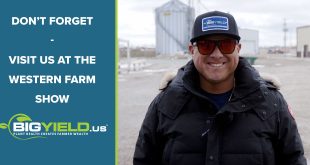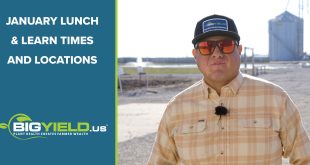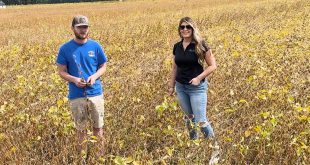To round out our “High Yields 101” series, we wanted to share with you Shane Hall’s top 5 tips for the 2021 growing season. If you haven’t already, be sure to go back and watch our other videos in this series.
Video Transcript
Hello everybody it’s good to be with you again, my name is Shane, I’m the CCA for BigYield and we’re going to talk a little bit today about what I would call my big five as far as yields are concerned. We’re all looking forward to that next year where we can improve on the year before and make some good management decisions on our farms, not just to get those mediocre numbers, but all of us are wanting those big yield numbers for the upcoming year. So I’ve five things that I’d like for you all to think about as we move forward into 2021, the first thing being soil health, number two weed management, number three seed selection, number four fertility, and number five scouting. You have to give our attention to our fields. Taking those one by one, first of all is our soil health and I know I preach about this a lot, but we have to have our soils right and if nothing else even our pH has to be on and in order for our inputs to be taken up the way they need to be taken up. We can’t afford to waste dollars on putting in those inputs only for it to be washed away in the soils or for our plants that don’t have the ability to take it up because the pH is too high or our soil is too alkaline or our soil is too acidic, so we gotta make sure our organic matter is right, we gotta make sure our CC levels are on point so that those cations can be exchanged properly and so that our plants will have the best opportunity they can in order to grow. I know after the plant comes up you’re putting inputs in your foliar feeds and all that, but if stuff isn’t right under the ground, that’s just more dollars going away, so we have to have good fertility in the soil and a good start in our dirt. That would be my number one thing before we start anything. If you’re renting ground for the first time or even if you’ve been farming a particular piece of ground for a few years, we have to not ignore the elephant in the room or the elephant in the combine I guess you may say. So we’re asking questions like what went wrong here, we have to start with our soil fertility.
The second one of course is our weed management and after I think after my soil fertility, what does my weed program look like. Am I using to the best of my ability the chemistries that will work best in my field and in my management process. If I’m just kinda staying with the same old same, and hoping the weather is perfect to get it in the field on time and all those things, and not making plans and then contingency plans in order to manage my weeds, then I’m going to have issues. It doesn’t do us any good to blame other things when we know we have a weed problem when we know we’ve got resistant weeds, which we know are getting more and more prevalent as the years go by, we’ve got resistant water hemp, we’ve got resistant mares tail, those things are becoming more and more pesky and it seems like we control the cockle burrs early in the season, lo and behold it comes back later on. What’s our plan for that, what are we going to do to those yield dropping weeds when they pop up in our fields? Have that plan, know ahead of time what we’re going to do in order to manage those things and to eradicate those problems in our fields because again, as things build, you have the soil health right, seed selection was great and so on and so forth, then we’ve got a weed problem all of a sudden and well it’s just frustrating to have those issues, so let’s start with the soil health, let’s build to our weed management program and make sure that’s what we got those things correct.
Next thing is seed selection, why did I put that at number three. Seed selection because your farm is not the same as your neighbor’s farm. You could go from this 50 acres to another 50 acres and you’ve got a different kind of soil, you’ve got different elevation, elevation changes, field ruts different that your neighbors, there are so many different things, how much topsoil do you have. If you could go from one part of the field to the next and find a difference in pH, just imagine how much it can change from a mile down the road or whatever it may be. So what seed I put in that particular soil is going to make a difference. I’m just a real big fan of this particular seed where ever no matter what, or am I going to make sure I’m hedging my best, I’m spreading my risk as far as my seed selection is concerned and I’ve got a good bottom bean, or I’ve got corn that does better with wet feet if I’ve got bottom ground, or if I have hilltop ground and I know it dries out, then I’m not going to go with that bottom ground corn, even though the year before it did great in the bottom ground and made me 200 bushels, so I’m going to go with it on the top shelf as well. We can’t do that, we know we have to make the right seed selection for the ground we’re working with. There’s a lot of great genetics right now both in the GMO section and in the non-GMO stuff. There’s a lot of good non-GMO corn and the genetics are excellent and the drought guard’s are excellent at those things. So make sure we’ve got the right seeds in the right place and I think that’s going to help us in the long run. Our seed selection could have to do with our weed program too in that roundup has ran its course in the particular field, and I have too many resistant weeds and I have to go with something else. I’m not telling you guys anything you don’t know or haven’t thought of, but just make sure that you’re having these conversations with your seeds salesman, make sure you’re talking to them about the benefits and the strengths and the weaknesses of this particular cultivars your putting or deciding to put in your fields.
So we have soil health, weed management, then we’re selecting the right seeds, then finally we’ve got our number four our fertility. Is fertility different from soil health? Yes, and I’ll tell you why. In the world or agronomy they talk about the four R’s, the preach the four R’s. So within the five points I’m giving you, I’m giving you another four sub-points under this heading. The four R’s of nutrient management are making sure when we’re making our fertilizer applications, we’re being responsible with those and we’ve got the right source, the right rate, the right time, and the right place. So when we think about those things, where is my fertilizer coming from, that’s important to all of us and knowing that it’s sourced responsibly and correctly, and that the numbers are where they need to be as far as making sure that what I’m putting in my field, what’s on the bag, what’s in the estimation is exactly what I’m putting my field. I need to know how many pounds of nitrogen per acre that I’m actually putting on. What is my estimated ECC for my lime for example. So the right source, the right rate, making sure that we’re not over doing it or under doing it, that rate may depend on us doing it at different times. Split Applications. The right time, again that could be split applications, it could be for corn going all in at the front, you’ve got to field that’s got good organic matter that’s going to hold onto your input, and that it’s not going to leach or be washed away. So you’ve got to have a good place to have it. Source, rate, time, and place. The four R’s of nutrient management, those are the important things you need to be thinking about when it comes to our fertility.
Finally scouting. I know that this is a hard one but we have to spend time in our fields, if there was anything I would say that folks aren’t doing, farmers aren’t doing as much as they should be doing, is scouting and I’m not necessarily saying you have to hire somebody to come do it, but if that’s what it takes, that’s what it takes because we’ve got to spend time in our fields. Driving by looking out the windshield, it’s not going to cut it, you have to spend time out there. You would say, Shane I spend lots of time out there right I’m working my ground by the time I get in my sprayer and go across it however many times and I’m planting and I’m in the combine, I’m spending a lot of time out there in those fields. Yeah I know but what about those times, but what about those months where the crop is growing whether it be soybeans or corn, there’s so many things that could be happening within those growing months, that could really tell you a lot about what’s going on in your field, and what’s going on with your soil health and you weed management. A lot of those thighs you may not even know until you get out there and really spend time in the fields. If it’s the case that you need to get with an agronomist or get with someone like myself, I’d love to spend time out in the fields walking those things and giving the farmer an entire full picture of what he’s got in that particular field on that particular farm. It’s important for everybody to know what’s going on in their fields on a weekly basis. At least that seven to ten day when things can absolutely switch and the winds can change and the weather can change and all those things can wreak havoc in your fields so get out there, look and get a visual of what’s going on in your fields. So going over them again, soil health is number one, weed management, seed selection, fertility, and then finally making sure we’re getting in our fields and scouting them.
So those are my top five things going into 2021, the things that we can put down on paper and even in order make sure we’ve got things going in the right direction.
 BigYield High Yield Soybeans, High Yield Corn, and High Yield Wheat
BigYield High Yield Soybeans, High Yield Corn, and High Yield Wheat



